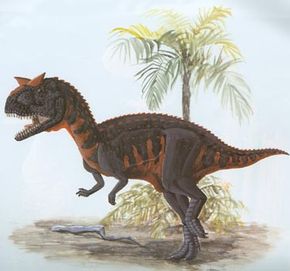CARNOTAURUS (CAR-noh-TORE-us)
Period: Early Cretaceous
Advertisement
Order, Suborder, Family: Saurischia, Theropoda, Abelisauridae
Location: South America (Argentina)
Size: 21 feet (6.5 meters)
This recently described genus was an unusual theropod. Carnotaurus (its name means "meat bull") is known from a single, nearly complete skeleton that had skin impressions over much of the skull and body. It was so complete because it was preserved in a large concretion (a lump of rock that is harder than the rock around it) that protected the bones and skin impressions. It was found in Early Cretaceous rocks in the Patagonia region of Argentina.
Its skull had stout horns above its very small eye sockets. Its bladelike, serrated teeth were much like those of other theropods. The arms of Carnotaurus were short for its body size, but unlike Tyrannosaurus with its slender arm bones, the arms of Carnotaurus were stout. Its arms were so short that it almost looked like the hands were attached to the upper arm bone (the humerus). The bones in the back and tail (vertebrae) were also unusual; they look a little like the wings of a fantasy spaceship.
The most exciting feature of this animal is its skin. It is more common to find skin impressions of hadrosaurs (duckbilled dinosaurs); theropod skin impressions are rare. The skin impressions of Carnotaurus show that its skin was made of many low, disklike scales with larger semiconical scales in rows along its sides. Like the skin of all known dinosaurs, these scales did not overlap like scales on some lizards and snakes.
Carnotaurus and other South American Cretaceous dinosaurs were much different from related animals in other areas of the world, even North America. This group of animals supports the theory that during the Cretaceous Period South America was isolated from the rest of the world, so the animals evolved differently. The unusual and exciting Cretaceous dinosaurs of South America are just beginning to be worked on and will reveal a great deal of information in the near future.
Advertisement
